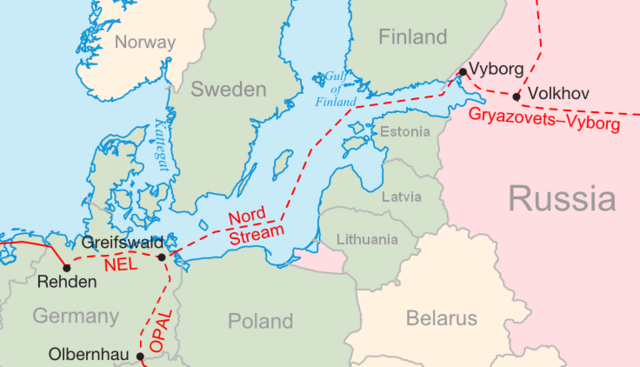
Nord Stream pipeline
Why in News?
The renewed tensions between Russia and Ukraine have raised the issue of Nord stream Pipeline.
Introduction
Nord stream pipeline is owned by Gazprom a Russian energy company.
It is longest export subsea pipeline running under Baltic Sea carrying gas Russia to Europe.
Bovanenkovo oil and gas condensate deposit in western Serbia are the source of gas for the pipeline.
The significance of the pipeline is that it bypasses the transit countries and hence making it reliable for European countries.
It is longest export subsea pipeline running under Baltic Sea carrying gas Russia to Europe.
Bovanenkovo oil and gas condensate deposit in western Serbia are the source of gas for the pipeline.
The significance of the pipeline is that it bypasses the transit countries and hence making it reliable for European countries.

The Nord stream Pipeline
Consist of two pipelines having two lines each.Consist of two pipelines having two lines each.
Nord stream 1:
Completed in 2011
Runs from Vyborg in Leningrad to Lubmin near Greifswald, Germany
Nord Stream 2:
Completed in 2021
Runs from Ust-Luga in Leningrad to Lubmin. Germany
Both pipelines can transport a combined total of 110 billion cubic metres (bcm) of gas a year to Europe for at least 50 years.
Exclusive Economic Zones (EEZs) crossed by the Nord Stream:
1. Russia
2. Finland
3. Sweden
4. Denmark
5. Germany
The territorial waters crossed by the Nord Stream:
1. Russia
2. Denmark
3. Germany
In Germany, the pipeline connects to the OPAL (Baltic Sea Pipeline) and NEL (North European Pipeline) which further connects to the European grid.
Objections against Nord stream
1. Strategic objection:
According to US it will make Europe too dependent on Russia.
Ukraine’s objection is based on fact that it will lose around $2 billion in transit fees.Russia could use it as geopolitical weapon.
The U.S. has said it will stop the Nord Stream if Russia attacks Ukraine.
Countries like Poland and Belarus also stand to lose transit fees and hence oppose the pipeline.
2. Environmental:
It does not fit in with German efforts to cut dependence on fossil fuels and fight climate change.
The project is also awaiting approval from the European Commission.
Importance of Nord stream to Europe and Russia
- Europe requires more than 100 billion cubic metres (bcm) of natural gas each year for domestic and industrial purposes.
- 40% of the gas to Europe comes from Russia.
- Reducing dependence on Russian gas is difficult as there are no easy replacements.
- Germany’s transition to cleaner fuels by phasing out nuclear power and cutting reliance on coal has increased its dependence on Russian gas as gas is seen as a cleaner fuel.
- Many European businesses have large investments in Nord Stream 2 and there is pressure on governments from these businesses.
- A reduction in gas from Russia would increase already high gas prices and that would not be popular domestically.
- 40% of Russia’s budget comes from sales of gas and oil.
- Nord Stream 2 is important because it eliminates the risks related with sending gas through transit countries, cuts operating costs by doing away with transit fees and gives direct access to its most important European customer, Germany.
Conclusion
Bargaining Chip:
The Nord Stream 2 is being used as a bargaining chip by the West to force Russia to de-escalate tensions with Ukraine.
The Nord Stream 2 is being used as a bargaining chip by the West to force Russia to de-escalate tensions with Ukraine.

